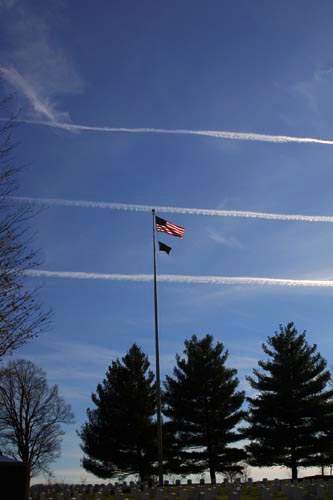by aw
Friday, Jun. 10, 2005 at 5:13 AM
This is so good for you you are going to grow another foot and never need food, air, or water again! So-called physicist Bernard Eastlund proposes using microwave beams to prevent tornadoes.

chemtrailflag.jpglrbzjh.jpg, image/jpeg, 333x500
www.findarticles.com/p/articles/mi_m0BFU/is_15_86/ai_73533123
Current Science, April 20, 2001 by Suzanne Mengel
Bernard Eastlund has a score to settle. Back in 1982, Eastlund had just moved to Houston, Texas, when a tornado hit his property. The tornado didn't hurt him or his house, but it mowed down all his pine trees. "That was scary enough" he said.
Eastlund, a physicist and head of the Eastlund Scientific Enterprises Corporation in San Diego, is now plotting his revenge. He says microwave beams shot into thunderstorms can zap tornadoes before they're even born.
BIRTH OF A TWISTER
Eastlund believes he can prevent tornadoes by halting the formation of mesocyclones--huge, swirling columns of air that occur during thunderstorms. In a thunderstorm, warm, humid air near the ground rises. As the air moves upward, it starts to spiral. At a certain point high above the ground, the warm air runs into a layer of colder, heavier air. That cold layer acts as a barricade, forcing the spinning air back down again to form a mesocyclone. If the mesocyclone touches the ground, it becomes a more tightly coiled funnel of spinning air, or a tornado, and mayhem may ensue.
Continue article
Advertisement
Mesocyclones might be stopped, says Eastlund, by busting the cold air barricade with microwave radiation--the same electromagnetic waves you use to nuke popcorn in a microwave oven. According to Eastlund's calculations, raindrops in the cold barricade would absorb the microwaves and release as much as a billion watts of energy. That energy would heat the surrounding cold air and smash the cold barrier the way dynamite demolishes a concrete wall. With no barrier in place, warm, spinning air would continue rising instead of being forced back down to form mesocyclones and tornadoes.
SPACE BEAMS
How on Earth could a microwave beam nuke a mass of air? Not from Earth, but from space. Eastlund proposes having Earth-orbiting satellites do the job. Solar panels on the satellites would collect energy from the sun and convert it to microwave beams. Eastlund calls his proposed satellites Thunderstorm Solar Power Satellites (TSPS).
The National Aeronautics and Space Administration (NASA) toyed with a similar idea in the 1960s as a way of creating an alternate energy source for Earth. NASA planned to have microwaves beamed down to receiving stations on Earth, where the beams would be converted to electricity.
Eastlund first came up with his idea for blasting tornadoes during the mid1980s while working for an oil exploration company in Alaska. At the time, the U.S. government was exploring a plan called the Strategic Defense Initiative (SDI) to shield the country from nuclear attack.
One idea for SDI involved opening a missileproof umbrella of high-energy electrons over the United States. Eastlund suggested erecting large microwave antennas, powered by Alaska's huge natural gas reservoir, that would fire microwaves into the ionosphere. The ionosphere is a layer of the upper atmosphere full of charged particles. The microwaves and the ionosphere's charged particles would interact and release hordes of electrons. Those electrons, attracted by Earth's magnetic field, would form a missileproof dome over the United States.
The SDI plan never went further than the development stage. So Eastlund began pursuing other applications for microwave beams.
Eastlund teamed up with colleagues at the University of Oklahoma's Center for Analysis and Prediction of Storms. There, they created computer simulations of violent weather conditions, then ran the simulations on a Cray C90, the world's fastest type of supercomputer. The simulations helped Eastlund determine how strong a beam he would need to zap a mesocyclone.
TEST RUN
Sometime in the next decade, Eastlund hopes to test his theory. To do that, he says, he will need a sophisticated Doppler radar system that can look downward from a satellite and locate mesocyclones within thunderclouds. He will also need access to instruments on board the International Space Station to create minibursts of microwaves to test whether they have enough power to heat even the slightest amount of air in a storm cloud.
Some scientists are skeptical of Eastlund's idea. Harold Brooks, a research meteorologist at the National Oceanic and Atmospheric Administration's National Severe Storms Laboratory in Norman. Okla., doubts tornadoes can--or should--be tamed. "If we take that option away from the thunderstorm, it may respond in some way that is even less friendly than a tornado," he said.
Eastlund is optimistic, though. He hopes that by the time he's ready to start running experiments, a new generation of scientists and engineers will be helping him out. Already, he's heard from one interested middle school student. Eastlund helped the boy create a mini-mockup of his satellite system, "One of my proudest moments," said Eastlund, "was [when] the 11-year-old [got] an A+ on his science project."
• Eastlund Scientific Enterprises Corporation
Eastlund Scientific Enterprises Corporation (ESEC) Provides Scientific, Engineering and Technical Services. Contact us with your requirements. | Home | About The Company | Fusion Torch | Current ...
www.eastlundscience.com...
• EIJ Fall 94: ARCO, Eastlund and the Roots of HAARP
Fall 1994- ARCO, Eastlund and the Roots of HAARP By Gar Smith All atomic and electronic technologies ... of energy on-site -- in the wilds of Alaska. Bernard Eastland, an MIT and Columbia University ...
www.earthisland.org/journal/haarp3....
View

